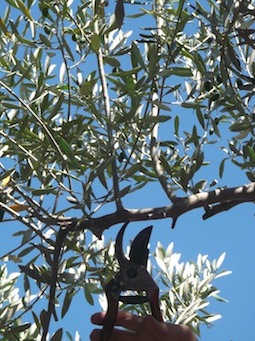gardener tools needed for difficult cuttings, and Things which affect rooting
Notes on gardener tools needed taken from Jim Gardiner. 1997. Propagation from Cuttings the A Wisley Handbook for the Royal Horticultural Society. London: Cassell, with comments on this particular gardener's circumstances.
WHERE AND WHEN YOU CUT FROM THE MOTHER PLANT
C/N LEVEL
High Carbohydrate levels (stored food) and medium to low Nitrogen levels in parent plant improve rooting. Avoid ‘rankly growing lush and succulent material’ (Gardiner 1997:6).
JUVENILITY (youthfulness of growth)
Difficult plants especially. Those that have not flowered or set seed root more easily as this makes them start to age. You can prune to encourage strong growing non flowering shoots, to take cuttings from. I wonder about strong non flowering shoots and the instruction to avoid rankly growing, lush material. How do you tell the difference between the two.
WOOD
Terminal (end of branch) or lateral (side) shoots, basal (the base) or tip sections of a shoot, heels (see below) and flowers all affect the rooting. The best method to use varies so much from plant to plant that a 12 page chart is needed. It is quite an English book in terms of plant choices as can only be expected. I like that there are instructions on how to grow several kinds of berries.
TIMING
By this is meant time of year of taking the cutting. The optimum time also varies so much between plants they are tabulated on the chart.
HOW YOU PREPARE EACH CUTTING
USE ROOT HORMONES.
They are absorbed through the cut section of the stem. The packaging usually has instructions.
As I said in the section on growing your own cuttings, I believe that these unstable hormones become dissolved in the water in which the plants are rooting, so that they spread from one cutting to another.
APPLY FUNGICIDE
I am not too sure of this, if there is a natural way, I’d use it, and vermicast contains natural fungicide. I would add some worm tea to the water and some vermicast to the potting soil for cuttings. This natural fungicide also contributes to the high success rate of germinating seeds in vermicast. Fungus kills many freshly sprouted seedlings before they have time to grow leaves even. I’ve heard this phenomenon called wilt off.
WOUND THE CUTTING
Especially on old wood. Wound to allow root hormone etc. to penetrate into the cutting. I have also read that the wound acts as a dam, so that natural rooting hormones in the cutting, flowing down to the base, pile behind it, and their concentration forces a root to develop. Believing in this idea, I make a small horizontal cut just below the bottom most node, but I'm not always successful. Gardiner recommends a vertical slit in the wood, of about 2cm or 1 inch length.
A heel cutting is explained here
WHERE YOU ROOT THE CUTTINGS
The special species specific knowledge and the gardener's tools needed come into play with cuttings which are difficult to root. Water, light and temperature are the important variables. The shoot has been cut off from the plant and has no more water supply via the mother plant, so water management is crucial. The water pH should be slightly on the acid side of neutral, making rain water ideal. Light is necessary for photosynthesis which initiates root growth. Except hardwood cuttings, they have a stored energy supply. But the growth of the roots should be ahead of leaf growth, so what is called bottom heat should be applied, making the base temperature slightly higher than the air temperature around the leaves (Gardiner 1997:9).
The softer and less hardy the plant, the more management it needs. Only willow, poplar and some berry plants will root ‘out of doors’. (Does he mean because of the cold).
sophisticated or simple gardener tools for propagating plants
His next bit of advice is obviously for northern climates. He recommends using north facing cold frames for temperature stability, making them draughtproof with snugly fitting parts, insulated with polystyrene so that the rooting compost can build up some warmth, and protected with sack cloth when frost threatens.
Pondering on South African circumstances and low tech backyard equipment for propagating olives
Translated into more general and then into South African circumstances, this important gardeners tool for successful propagation basically means a sealed off space into which light penetrates, that is protected from full sun, extreme cold and heat, and has a little warmth coming from below. The back alley of our house that gets no direct sunshine, though you can see the sky, and the shade under dense trees is perhaps too much shade. In the southern hemisphere the side away from the sun is the south, so this would translate into south facing frames (box on the ground with a sloping glass roof) but I think its a more difficult technology for us, because even in the southernmost tip of Africa, Cape Town, the sun is nearly overhead in summer and will probably cook the plants, unless there is partial shading. What most people use here commercially is a semi shaded greenhouse or plastic tunnel. Frost is not a problem though it is in the dryer areas of this country. On a much smaller scale though, I’m struggling for the perfect solution for really difficult plants. Many root on a not too hot windowsill, in a jar or in soil with a transparent cover, or without any covering but very regular watering, outside in partial shade. Perhaps for stubborn plants bottom heat may make all the difference, and one could build mini solar traps. A flat black box on the window sill, covered with clear plastic with holes in it into which pots of soil fit. Filled with water, the water would heat evenly and gently warm the base of the pots as well as ensure humidity. One could then cover the whole with a clear plastic cover, as an option. My horticulturist acquaintance lent me an aquarium heating blanket. They are cheap, but don’t apply heat evenly, so require constant replacement of damp towels apparently. They cannot be used outside because they are not weather proof, and use electricity. They are way too large for a window sill, but perhaps draped half over it, with a long thin metal dish ontop, filled with water, in which the pots stand, and placed on a semi shaded windowsill, it may work. I've had the most difficulty with olives, and the olive cuttings were taken from the routine pruning of the tree, and most of the shoots removed are hair like shoots, and suckers, which fit into the non flowering fruiting category that is supposed to be good according to Gardiner, above. The pictures are from my article on my other website edenfound@weebly.com , where I explain how to prune an olive tree with simple gardener's tools. Authors on propagating olives recommend bottom heat, which I ignored, because I thought it was a thing needed in freezing climates. The online writing also recommends taking cuttings after fruit has set. Perhaps this is wrong, the shoots are no longer ‘juvenile’. However, since they shed their leaves if you look at them twice, or don’t look at all, perhaps really ripe twigs, well on in the season will have enough carbohydrates in storage to overcome the loss of leaves. They are also growing out of direct light at any time of day in that alley. Perhaps one of these factors is the reason why my olive cuttings have not rooted. I will have to work on all these factors one by one to eliminate them.

vertical suckers must be pruned anyway
---------
home page: home gardening conserving resources
----------
----------
grow your own cuttings, general info
------
vegetable gardening the natural low cost way
----------
stage 1 measuring up and green garden design
Restore Nature Newsletter
I've been writing for four years now and I would love to hear from you
Please let me know if you have any questions, comments or stories to share on gardening, permaculture, regenerative agriculture, food forests, natural gardening, do nothing gardening, observations about pests and diseases, foraging, dealing with and using weeds constructively, composting and going offgrid.
SEARCH
Order the Kindle E-book for the SPECIAL PRICE of only
Prices valid till 30.09.2023
Recent Articles
-
Rose
Dec 17, 23 04:08 AM
I am doing research on growing wildlife foraging plants to use in enhancement plantings with wildlife in mind. My thoughts after seeing bears too skinny -
Seeds for a bred Sweeter less acidic Kei apple
Nov 20, 23 03:24 AM
Greetings Greenidiom, I'm a small farmer in kenya. I'm looking to plant a Green fence around a 6 acre plot of land and, I'd wish to make it of kei apples -
Mrs Laura Robinson
Oct 08, 23 02:17 AM
How do I get a copy of the soil aggregation poster??
"How to start a profitable worm business on a shoestring budget
Order a printed copy from "Amazon" at the SPECIAL PRICE of only
or a digital version from the "Kindle" store at the SPECIAL PRICE of only
Prices valid till 30.09.2023






